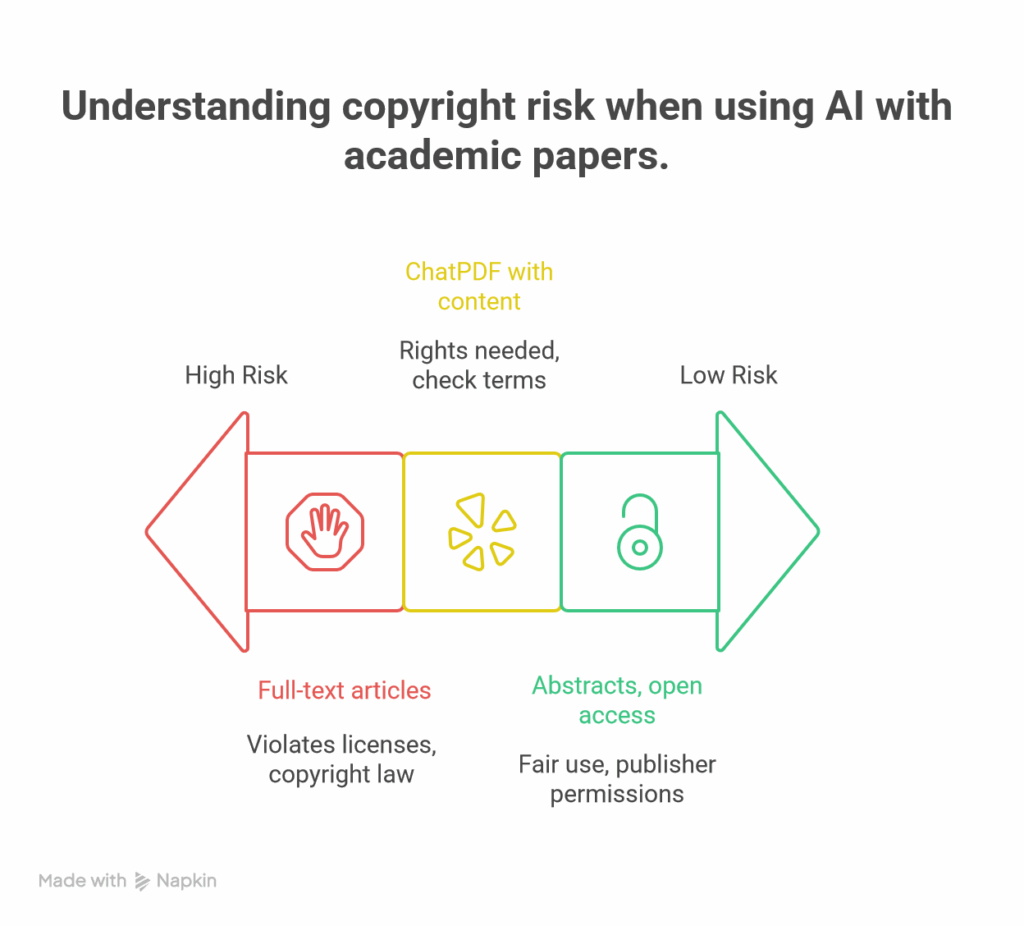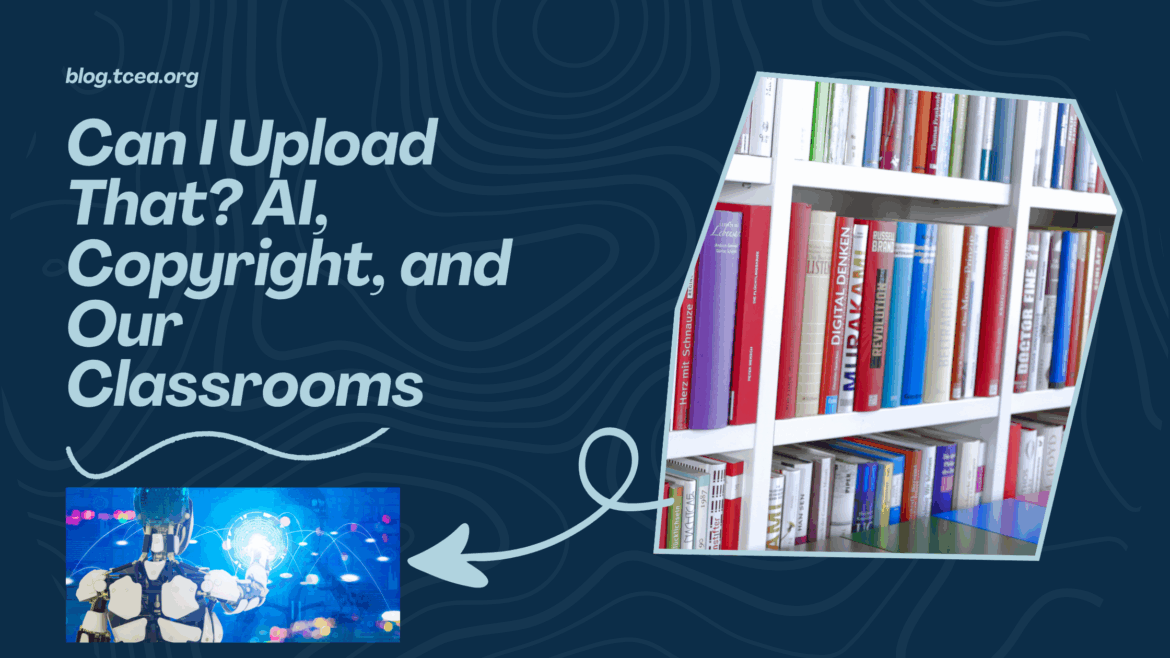Have you ever found the perfect article for your lesson and thought, “I could drop this into ChatGPT and get everything I need in seconds?” Ok, hang on a second. Let’s take a moment before you do that. I recently heard a university professor encourage that behavior. Even though Big Tech may have skirted some copyright issues, that doesn’t mean a key tenet of digital citizenship goes out the window.
The Upload Dilemma: What’s Legal and What’s Not
When we access articles through our school or university library databases, we still have to be aware of specific license agreements. Libraries and librarians serve as our digital gatekeepers. Through them, we get access to incredible resources. But it’s not a simple YES/NO, this or that, binary choice.
“I have access through my library subscription, so I should be able to use it however I want, right?” It’s easy to get caught in the web of various issues, such as:
- License Violations: Library database agreements typically forbid redistributing content to third-party platforms—including AI tools.
- Copyright Infringement: Uploading entire works without permission is reproduction that often falls outside fair use protections.
- Institutional Risk: Your school’s acceptable use policies likely prohibit actions that could create legal liability.
While we have access for reading and research, we do not have it for republishing. That is what happens when we take full text articles, print or digital, then put that content into an external Gen AI tool for summarization, analysis, or reformulation. We are republishing the content.

Research Tools: A Gray Area Worth Understanding
Tools like Research Rabbit help us discover papers. However, they do not alter the copyright status of what we find. Tools like ChatPDF might seem designed for analyzing documents, but their terms of service typically require that users have the legal right to upload the content. That’s the gray area.
You may have access via a library to digital content for reading, but not for republishing and placement in a third party Gen AI tool. When you do, you violate terms of service. That may also involve violation of copyright law. While some entities may be able to get away with that, ask yourself, “Am I financially prepared for a legal battle with a rich publisher or copyright holder?” My own response to that question is, “Probably not.”

The Abstract Solution: Less Is More
One approach you CAN take involves sharing the part of articles intended for that purpose. That is, the abstract of the article.
Abstracts are usable for this because:
- They’re intended for wide distribution by publishers
- Using such a small portion likely qualifies as fair use
- They contain the core concepts and findings of the research
- They’re perfect for AI analysis of themes and potential discussion points
A Friendly Workflow That Respects Copyright
Another way to imagine this might include these areas:
- Find Your Source: Locate relevant articles through library databases or tools like Semantic Scholar.
- Extract the Abstract: Instead of downloading the full PDF, copy just the abstract text.
- Craft Your Prompt: Ask your AI something like: “Based on this abstract, generate five discussion questions at varying difficulty levels for my 10th-grade class.”
- Differentiate Content: Use the AI-generated questions in a collaborative space like Padlet, assigning different questions to students based on readiness levels.
- Extend Learning: Have students search for additional sources that might answer the questions raised by the abstract.
Could an approach like this better support the needs of learners in your classroom? If so, give it a try.
When You Can Upload Full Content
There are situations where uploading full content is acceptable and allowed. In fact, there’s nothing so much fun as grabbing content shared in these ways and seeing Gen AI tools work their magic:
- Open Access Articles: Works published under Creative Commons licenses
- Your Original Work: Materials you’ve created yourself
- Public Domain Content: Works where copyright has expired
- Materials With Explicit Permission: Content where the rights holder has granted upload rights
In these cases, you can leverage AI’s full potential without copyright concerns. Here are some specific resources as examples for three of the content types listed:
Open Access Articles: Works published under Creative Commons licenses
- PLOS ONE – One of the world’s largest open access journals publishing research across all scientific disciplines under CC BY license
- BMC Medicine – A leading medical journal publishing research articles under Creative Commons licenses
- Nature Communications – A multidisciplinary open access journal from Nature Publishing Group
Public Domain Content: Works where copyright has expired
- Project Gutenberg – Over 70,000 free eBooks including classic literature and historical texts
- Internet Archive – Millions of free books, movies, music, and historical documents
- Wikimedia Commons – A repository of over 90 million freely usable media files
Materials With Explicit Permission: Content where the rights holder has granted upload rights
- Khan Academy – Educational videos and resources available under CC BY-NC-SA license
- OpenStax – Free, peer-reviewed textbooks with explicit permission for educational use
- MIT OpenCourseWare – MIT course materials published under Creative Commons licenses
There are many more, but these are offered as examples. Please feel free to include others in the blog comments.
Model Digital Citizenship
As educators, we are the role models in K-Adult classrooms and spaces. The best reason to be careful about copyright is that we model for students to be respectful of intellectual property. At a time when anything can be digitized and used without citation or remuneration, the ethical use of Gen AI falls on the educators in the room. This can be a valuable lesson for others based on our actions, not on our espoused beliefs.


3 comments
The article “Can I Upload That? AI, Copyright, and Our Classrooms” tackles a pressing question for educators in the AI era: when is it legally acceptable to upload source materials into generative AI tools? The author explains that just because students and teachers have access to articles through library subscriptions doesn’t mean those works can be freely uploaded to AI platforms doing so could violate license agreements and copyright law.
Great article… as always! I’m glad you are talking about this… not many people in the education and AI debate are! I do (think?…this stuff makes my head spin) I disagree with the notion that using external Gen AI tools for summarization or analysis constitutes republishing. I don’t think there is a distinction, legally, between me summarizing an article I have a legal right to read/use (purchased, library access, licensed, etc.) and having an AI do that for me. The distinction may lie in whether the chat is used to train models, but that is also a rabbit hole! That said, I wholeheartedly agree with your overall conclusion regarding the ethical considerations we must navigate when using such tools.
Hey Jason, thanks for weighing in! I see your point. There’s actually a big difference between summarizing something yourself and uploading it to ChatGPT or Gen AI tool. It’s not really about who’s doing the summarizing. It’s about who owns the rights. The library has the license to those articles, not us as individuals. We’re just borrowing access.
When you upload to an AI tool, you’re literally making a digital copy on someone else’s servers. That’s the copyright violation right there, before any summarizing even happens. The library’s agreement specifically says “no redistribution” to third parties. Think of it like this: borrowing a book doesn’t give you the right to scan and share it, even if you’re just sharing it to get help understanding it.
Instead, maybe try pulling a few key quotes, jotting down your own thoughts (handwriting helps your brain remember better). Then, get GenAI to help you with your notes. You still get the AI assistance without crossing that copyright line. Always good to hash these things out as we figure out these new digital ethics questions together.
Thanks for commenting, Jason. Oh wait, have you been hanging out with Dr. Fryer? Yes, I see how this might have happened….
😉
Running for cover,
Miguel
🙂